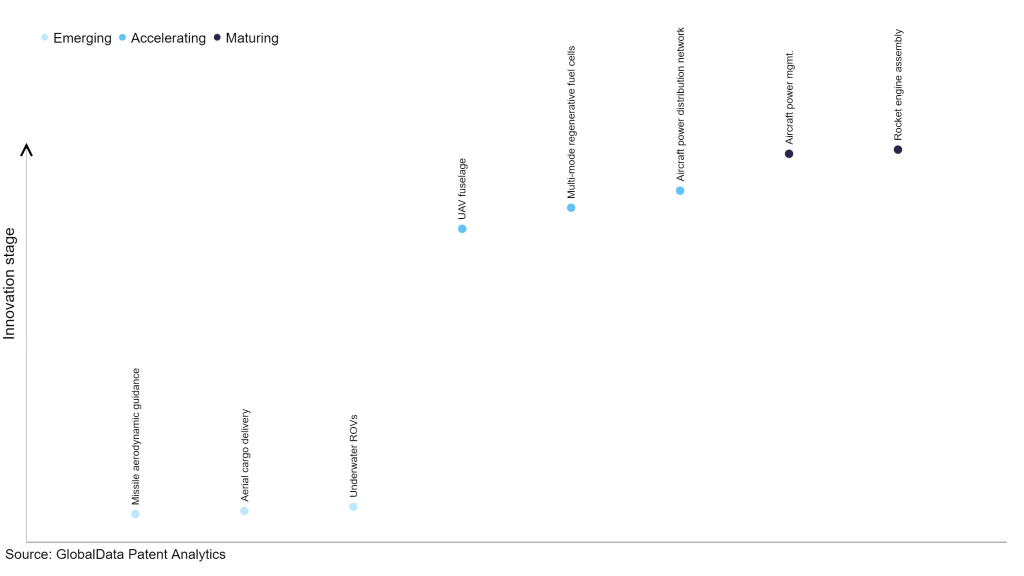The aerospace and defense industry continues to be a hotbed of patent innovation. Activity is driven by automation, environmental sustainability, and operational efficiency, and the growing importance of technologies such as artificial intelligence (AI), Internet of Things (IoT), drones, and satellites. In the last three years alone, there have been over 84,000 patents filed and granted in the aerospace and defense industry, according to GlobalData’s report on Innovation in defense: aircraft power management. Buy the report here.
However, not all innovations are equal and nor do they follow a constant upward trend. Instead, their evolution takes the form of an S-shaped curve that reflects their typical lifecycle from early emergence to accelerating adoption, before finally stabilizing and reaching maturity.
Identifying where a particular innovation is on this journey, especially those that are in the emerging and accelerating stages, is essential for understanding their current level of adoption and the likely future trajectory and impact they will have.
110 innovations will shape the aerospace and defense industry
According to GlobalData’s Technology Foresights, which plots the S-curve for the aerospace and defense industry using innovation intensity models built on over 260,000 patents, there are 110 innovation areas that will shape the future of the industry.
Within the emerging innovation stage, missile aerodynamic guidance, aerial cargo delivery, and underwater ROVs are disruptive technologies that are in the early stages of application and should be tracked closely. UAV fuselage, multi-mode regenerative fuel cells and aircraft power distribution network are some of the accelerating innovation areas, where adoption has been steadily increasing. Among maturing innovation areas are aircraft power management and rocket engine assembly, which are now well established in the industry.
Innovation S-curve for the aerospace and defense industry

Aircraft power management is a key innovation area in aerospace and defense
Aircraft power management refers to the systems and methods used to efficiently distribute and regulate electrical power in an aircraft. This involves controlling the supply of power to various electric devices and sockets on the aircraft, managing the charging and discharging of energy storage devices, and optimizing power distribution based on predicted energy demands and operational characteristics of the flight. Power management systems help reduce power draw, ensure reliability and redundancy, and maximize energy efficiency in aircraft.
GlobalData’s analysis also uncovers the companies at the forefront of each innovation area and assesses the potential reach and impact of their patenting activity across different applications and geographies. According to GlobalData, there are 30+ companies, spanning technology vendors, established aerospace and defense companies, and up-and-coming start-ups engaged in the development and application of aircraft power management.
Key players in aircraft power management – a disruptive innovation in the aerospace and defense industry
‘Application diversity’ measures the number of applications identified for each patent. It broadly splits companies into either ‘niche’ or ‘diversified’ innovators.
‘Geographic reach’ refers to the number of countries each patent is registered in. It reflects the breadth of geographic application intended, ranging from ‘global’ to ‘local’.
Patent volumes related to aircraft power management
Source: GlobalData Patent Analytics
Boeing is one of the leading patent filers in the field of aircraft power management. It filed patents related to electrical load management, current balancing within a modular converter system, advanced energy monitoring and control systems, intelligent energy management architecture, life-optimal power management methods for battery networks system, and regulated transformer rectifier unit for aircraft systems.
The company works with the US Air Force to develop advanced power-control and thermal-management systems for the next generation of fighter aircraft. These systems are crucial for integrating emerging technologies, such as laser weapons, potent electronic warfare capabilities and enhanced stealth features, into future jet fighters.
Some other key patent filers in this space include General Electric, Safran, and Airbus.
In terms of application diversity, Boeing, General Electric, and RTX are some of the leading innovators. By means of geographic reach, some of the leading patent filers include Plato Media, Kitty Hawk, and Wisk Aero.
To further understand the key themes and technologies disrupting the aerospace and defense industry, access GlobalData’s latest thematic research report on Aerospace & Defense.
Data Insights
From

The gold standard of business intelligence.
Blending expert knowledge with cutting-edge technology, GlobalData’s unrivalled proprietary data will enable you to decode what’s happening in your market. You can make better informed decisions and gain a future-proof advantage over your competitors.



